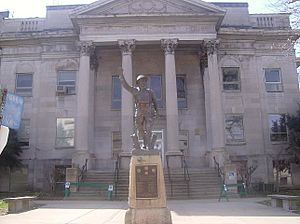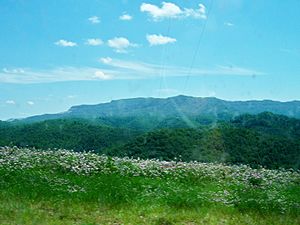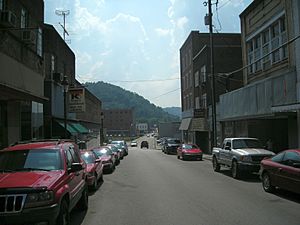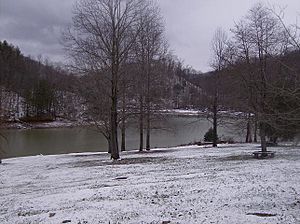Harlan County, Kentucky facts for kids
Quick facts for kids
Harlan County
|
|
|---|---|
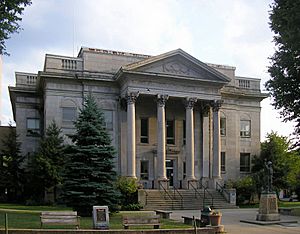
Harlan County courthouse in Harlan
|
|
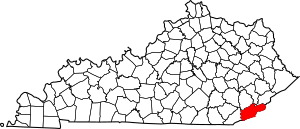
Location within the U.S. state of Kentucky
|
|
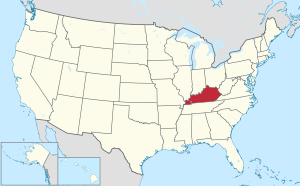 Kentucky's location within the U.S. |
|
| Country | |
| State | |
| Founded | 1819 |
| Named for | Silas Harlan |
| Seat | Harlan |
| Largest city | Cumberland |
| Area | |
| • Total | 468 sq mi (1,210 km2) |
| • Land | 466 sq mi (1,210 km2) |
| • Water | 2.3 sq mi (6 km2) 0.5%% |
| Population
(2020)
|
|
| • Total | 26,831 |
| • Estimate
(2023)
|
25,324 |
| • Density | 57.33/sq mi (22.136/km2) |
| Time zone | UTC−5 (Eastern) |
| • Summer (DST) | UTC−4 (EDT) |
| Congressional district | 5th |
Harlan County is a place in southeastern Kentucky. In 2020, about 26,831 people lived there. The main town, or county seat, is called Harlan.
Harlan County is famous for its connection to folk and country music. Many talented musicians have come from here. In the 1900s, it was a key area for workers' rights. There were often struggles between coal mine owners and union workers. A famous event was the Harlan County War in the 1930s.
The coal mining industry started to slow down in the 1950s. This meant fewer jobs, which led to fewer people living in the county and a tougher economy.
Kentucky's highest natural point, Black Mountain, is found in Harlan County. It stands at 4,145 feet (1,263 meters) tall.
Contents
History of Harlan County
Long ago, eastern Kentucky was home to many ancient Native American groups. They lived in cliff dwellings, which were like homes built into the sides of cliffs. These sites were used by different cultures over time, sometimes as homes and sometimes for burials.
In 1923, an Indian Cliff Dwelling was found near Bledsoe, Kentucky. It was built into a south-facing cliff, close to a stream. Experts from the University of Kentucky came to study the site. They helped start the first department for studying ancient cultures and history at the university in 1926.
Some of the Native American tribes who lived in this area historically were the Cherokee and Shawnee.
Before the American Revolutionary War, Kentucky was part of the Virginia colony. In 1776, it became Kentucky County. Later, in 1791, Kentucky County became a separate state, joining the United States on June 1, 1792.
How Harlan County Was Formed
Harlan County was created in 1819 from a part of Knox County. It was named after Silas Harlan. Silas Harlan was a brave scout and hunter who came to Kentucky in 1774. He became a Major in the Continental Army.
Silas Harlan fought in important battles, including the Illinois campaign against the British. He died in 1782 at the Battle of Blue Licks. His brother, James Harlan, later married Silas's fiancé, Sarah Caldwell. Their grandson, John Marshall Harlan, became a U.S. Supreme Court Justice.
Over time, Harlan County's size changed as new counties were formed nearby. Letcher County was created in 1842, and Bell County in 1867. Finally, in 1878, Leslie County was formed, setting Harlan County's current borders.
Coal Mining and Labor Struggles
Coal was a very important resource in Harlan County. As the country grew, the demand for coal increased. Mining was hard work, and miners often faced tough conditions and low pay. Because of this, workers tried to form unions to get better working conditions and fairer wages.
In the 1930s, there were many violent clashes between striking miners, company guards, and law enforcement. This period was known as the Harlan County War, and it led to the county being called "Bloody Harlan." After a big fight called the Battle of Evarts in 1931, the governor of Kentucky called in the National Guard to bring peace.
The struggles of coal miners in Harlan County have been featured in songs and films. The documentary film Harlan County, USA (1976) showed the efforts of miners to organize during another period of labor unrest in the 1970s.
Mixed Heritage Families
From the late 1700s to the mid-1800s, many families of mixed heritage settled in Harlan County and nearby areas. These families often had African, European, and sometimes Native American ancestors. Many were descendants of free people of color from colonial Virginia. Because their mothers were free, their mixed-race children were also born free.
Some of these families are part of a group called Melungeon. Their history has been explored through old photographs, DNA studies, and historical records.
In 2007, the Ridgetop Shawnee Tribe of Indians was formed. This group works to improve the lives of mixed-heritage families and to protect Native American history and artifacts in the area.
Recent Coal Miner Protests
In 2019, Harlan County was again the site of a coal miner protest. Miners demanded back pay from a coal company that had fired them after going bankrupt. They blocked a railroad track, stopping a coal train from leaving the county for almost two months.
Geography of Harlan County
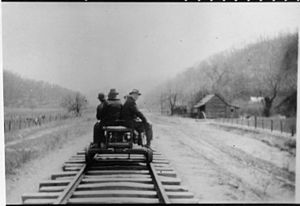
Harlan County covers about 468 square miles (1,212 square kilometers). Most of this area is land, with a small part being water.
Natural Features
The Cumberland River starts in Harlan County. It has three main branches: Poor Fork, Clover Fork, and Martins Fork. These branches meet in a place called Baxter.
Black Mountain is Kentucky's highest point. It is located east of Lynch and is 4,145 feet (1,263 meters) above sea level.
Main Roads
Neighboring Counties
Harlan County shares borders with these other counties:
- Perry County (north)
- Letcher County (northeast)
- Wise County, Virginia (east)
- Lee County, Virginia (southeast)
- Bell County (southwest)
- Leslie County (northwest)
Protected Natural Areas
- Cumberland Gap National Historical Park (part of it is in Harlan County)
- Blanton Forest
Economy and Jobs
For about 100 years, the economy of Harlan County was mostly based on coal mining. However, as coal production and mining jobs decreased, the county faced economic challenges.
The first coal shipment by railroad from Harlan County happened in 1911. Mining jobs grew a lot after that, reaching over 13,000 miners in 1950. But by 2016, the number of miners had dropped to only 764. During this time, the population of Harlan County also fell significantly.
In recent years, new job opportunities have started to appear. Teleworks USA opened a center in Harlan, creating over 200 new jobs by 2018. SEKRI, a company in the Blair community, also expanded and added 100 jobs.
Education in Harlan County
Colleges and Universities
The only college in Harlan County is Southeast Kentucky Community and Technical College. Its main campus is in Cumberland.
Public Schools
Harlan County has two public school districts.
Harlan County Public Schools
This district covers most of Harlan County, except for the city of Harlan. It has one high school, Harlan County High School, which opened in 2008. The school's mascot is the Black Bear, named after the growing number of black bears in the area. This new high school replaced three older high schools:
- Cumberland High School
- Evarts High School
- James A. Cawood High School
The district also runs several K–8 (kindergarten to 8th grade) elementary schools:
- Black Mountain Elementary
- Cawood Elementary
- Cumberland Elementary
- Evarts Elementary
- Green Hills Elementary
- James A. Cawood Elementary
- Rosspoint Elementary
- Wallins Elementary
Harlan Independent Schools
This is a separate school district just for the city of Harlan. It includes:
- Harlan High School
- Harlan Middle School
- Harlan Elementary School
Private Schools
- Harlan County Christian School (in Putney)
Fun Places to Visit
- Black Mountain Off-Road Adventure Area: This is a popular place for all-terrain vehicle (ATV) and 4WD vehicle riding. It has over 7,000 acres (2,833 hectares) set aside for these activities. Harlan County even holds a Guinness World Record for the largest ATV parade!
- Cranks Creek Lake
- Kentucky Coal Mining Museum
- Kingdom Come State Park: This park is near the city of Cumberland. It's named after a famous book, The Little Shepherd of Kingdom Come. The park has picnic areas, hiking trails, a fishing lake, a cave amphitheater, and cool rock formations like Log Rock and Raven Rock. It also hosts the yearly Kentucky Black Bear Festival.
- Martins Fork Lake
- Pine Mountain Settlement School
Towns and Communities
Cities
Other Communities
- Ages
- Alva
- Baxter
- Blair
- Bledsoe
- Brookside
- Cawood
- Chad
- Closplint
- Coldiron
- Cranks
- Dayhoit
- Elcomb
- Fresh Meadows
- Grays Knob
- Gulston
- Highsplint
- Hiram
- Holmes Mill
- Kenvir
- Pathfork
- Pine Mountain
- Putney
- Rosspoint
- Smith
- South Wallins
- Tacky Town
- Teetersville
- Totz
- Verda
- Wallins Creek
Famous People from Harlan County
- Bernie Bickerstaff, NBA coach
- Rebecca Caudill, author of children's books
- Jerry Chesnut, country music songwriter
- Carl H. Dodd, Korean War soldier and Medal of Honor winner
- Wah Wah Jones, NBA player
- Nick Lachey, singer, actor
- Cawood Ledford, University of Kentucky sports announcer
- George Ella Lyon, author and poet
- Florence Reece, songwriter
- Louise Slaughter, Congresswoman
- Jordan Smith, Winner of The Voice
See also
 In Spanish: Condado de Harlan (Kentucky) para niños
In Spanish: Condado de Harlan (Kentucky) para niños


